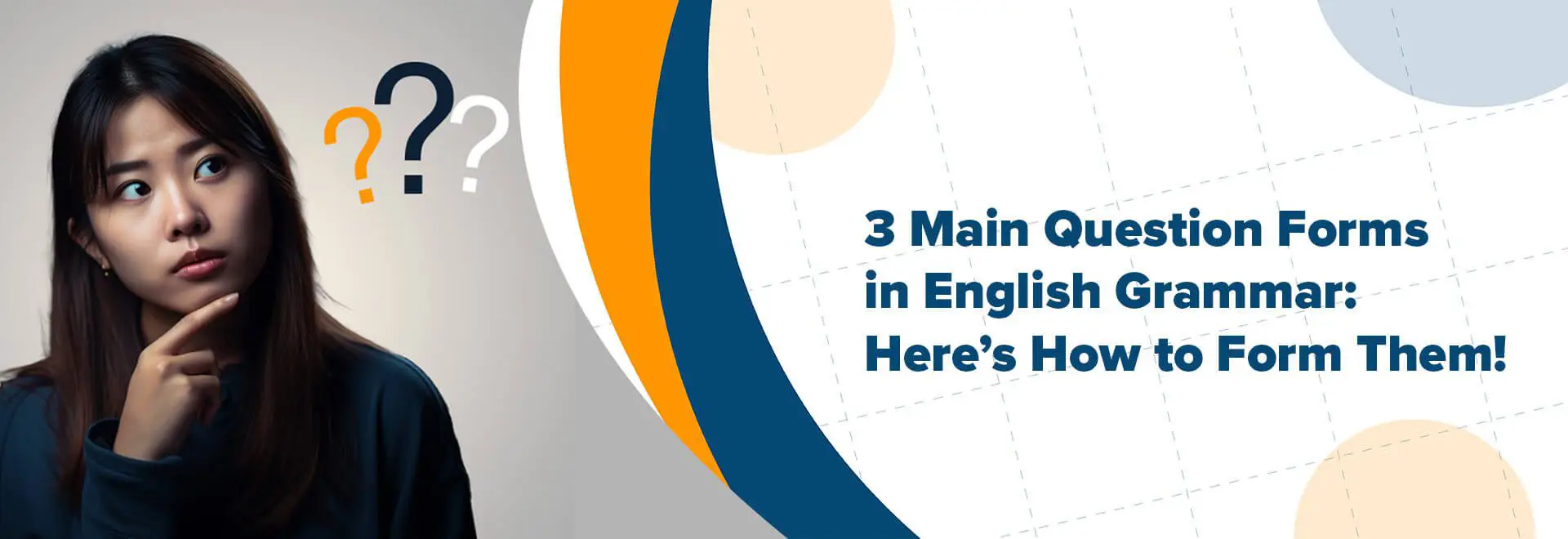
3 Main Question Forms in English Grammar: Here’s How to Form Them!
Asking questions is an essential part of communication in any language. In English, forming questions involves understanding the proper word order, question words, and auxiliary verbs. Are you familiar with how questions in English grammar are formed?
In this learning content, we will explore the three main question forms in English grammar, including yes/no questions, wh-questions, and tag questions, and learn how to form them accurately. Understanding the rules and patterns for asking questions will enhance your ability to engage in meaningful conversations and gather information effectively.
Table of Contents
Should we ask questions in English with a correct grammar structure?
Using correct grammar in questions helps ensure that your message is conveyed accurately and effectively. Therefore, the answer to the question is YES. It is advisable to ask questions in English with the correct grammar structure whenever possible. Knowing how to ask questions in English correctly and using proper grammar help ensure that your questions are clear and understandable, and effectively convey your intended meaning. It enables the recipient to comprehend your question accurately and respond appropriately.
What are question forms?
Question forms are structures of sentences that are used to ask questions and elicit specific information. They enable us to inquire about various aspects of a topic, gather details, and express curiosity. By using question forms, we can initiate discussions, clarify doubts, and engage in meaningful dialogues with others.
Role of question forms in English grammar
Question forms play a crucial role in English grammar by facilitating effective communication, information gathering, and active engagement. They enable us to seek information, express curiosity, clarify doubts, and promote meaningful conversations. By understanding and utilizing question forms appropriately, we enhance our language skills and become more proficient communicators.
The importance of question forms in communication cannot be exaggerated. They facilitate effective interaction, allowing us to exchange information, express opinions, and understand others better. Whether you are engaging in casual conversations, interviews, or formal discussions, question forms are essential tools for expressing curiosity, seeking clarification, and maintaining an active role in communication.
In the following sections, we will delve deeper into each question form, exploring its structures, providing examples, and offering practice exercises to help you master the art of forming questions in English grammar. Understand and practice these question forms to enhance your communication skills and become more confident in your ability to engage in meaningful conversations. At the end of this article, you can answer the sample exercise to assess your learning. Let’s get started!
3 main question forms in English grammar and how to form them
I. Yes/No Questions:
Yes/No questions are formed by inverting the subject and the auxiliary verb (or the main verb if there is no auxiliary verb) in a declarative sentence. In this question form, the question is typically answered with a simple “yes” or “no.”
Here’s the general structure:
Auxiliary verb + subject + main verb?
Example:
Declarative sentence: You are going to the party.
Yes/No question: Are you going to the party?
If there is no auxiliary verb in the declarative sentence, we use the auxiliary verb “do” to form the question:
Declarative sentence: She likes chocolate.
Yes/No question: Does she like chocolate?
II. Wh-Questions:
Wh-questions are formed using question words (such as who, what, where, when, why, how, etc.) and follow a similar pattern to Yes/No questions. In this question form, the question word is placed at the beginning of the sentence, and the subject and auxiliary verb (or main verb) are inverted.
Here’s the general structure of this question form:
Question word + auxiliary verb + subject + main verb?
Example:
Declarative sentence: They went to the beach yesterday.
Wh-question: Where did they go yesterday?
If there is no auxiliary verb in the declarative sentence, we use the auxiliary verb “do” to form the question, just like in Yes/No questions:
Declarative sentence: He plays the guitar.
Wh-question: What does he play?
III. Tag Questions:
Tag questions are short questions added at the end of a declarative sentence to seek confirmation or agreement. This question form consists of an auxiliary verb and a pronoun. The auxiliary verb in the tag question is typically a reversal of the main verb in the declarative sentence.
Here’s the general structure of this question form:
Subject + auxiliary verb in tag form + pronoun?
Example:
Declarative sentence: You like coffee, don’t you?
Tag question: Don’t you?
Note that the pronoun in the tag question corresponds to the subject of the declarative sentence.
Another example:
Statement: You are coming with me, aren’t you?
Statement: She didn’t eat dinner, did she?
Statement: He knows the answer, doesn’t he?
Important Notes to take:
The exact formation of questions may vary depending on tense, verb form, and subject-verb agreement. It’s important to consider these factors when forming questions in English grammar.

Common mistakes when forming questions in English Grammar
Forming questions with the correct question forms is an essential aspect of English grammar, enabling effective communication and the exchange of information. However, language learners often encounter common mistakes when constructing questions. Below are 5 common mistakes when forming questions in English grammar.
○ Failure to invert the subject and auxiliary verb
In most question forms, the subject and the auxiliary verb are inverted.
For example, instead of saying, “You are going to the party?” the correct form is “Are you going to the party?”
This is sometimes a common mistake of speakers. The declarative sentence has an intonation to make it sound like a question.
○ Forgetting to use question words
When asking questions, it’s important to include question words such as “who,” “what,” “where,” “when,” “why,” and “how” to specify the information you are seeking. For instance, instead of asking, “What time he left?” it should be “When did he leave?” or “What time did he leave?”
○ Incorrect placement of question tags
Question tags are short phrases added at the end of a statement to turn it into a question (e.g., “You like coffee, don’t you?”). Learners often place question tags incorrectly, such as “You like coffee, do you?” It’s important to ensure that the question tag matches the statement’s auxiliary verb and maintains the correct subject-verb agreement.
○ Omitting auxiliary verbs
In questions, auxiliary verbs like “do,” “does,” “did,” “can,” “will,” etc., are used to form the question structure. Sometimes learners forget to include these auxiliary verbs, resulting in incorrect questions. For example, saying “You like chocolate?” instead of “Do you like chocolate?”
○ Misusing verb tenses
When asking questions, learners might mistakenly use the wrong verb tense. It’s important to match the verb tense with the intended meaning. For example, saying “Did you saw that movie?” instead of “Did you see that movie?” where “saw” is the incorrect past tense of “see.”
It is sometimes not noticeable when people say the sentence wrongly because of the influence of their good pronunciation. If you intend to use “did” in your sentence, remember that it is already in the past. So make sure that the main verb you use should be in its present form to make the sentence correct.
To avoid making mistakes when asking questions, it is important to know the basic sentence patterns in English. By knowing it, you will be able to easily construct your sentence and form questions accurately. In addition, it is also crucial to be aware of the rules of intonation in English to convey meaningful sentences and purposeful conversations.
Sample Exercise for Self-Assessment:
Now you are ready to assess yourself. Let’s see if you can form a question based on the given responses. Click on the Practice Exercise button below to answer the quiz. You may check your answers after you take the test.




